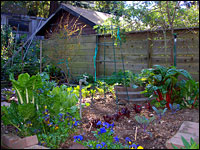This originally aired on WSHU Public Radio in Fairfield, Conn.
—–
“Gardens are viewed as ‘hobbies’ by most politicians/bureaucrats and administrators and are seldom taken seriously as real sources of real food,” says a University of Connecticut agricultural extension specialist, speaking of the United States Department of Agriculture. This attitude represents a serious impediment to a healthy, and sustainable food supply and society.
Feeding a growing population with shrinking resources without polluting the planet is one of the greatest challenges facing us, locally and globally. The USDA is the world’s largest agricultural research and extension organization. If it doesn’t take gardens seriously as “real sources of real food,” we are in real trouble.
Although we know that organic food sales are growing at over 20 percent annually, the USDA hasn’t collected statistics on organic farms. In Connecticut, there are about 40 certified organic farms, which, like many of the farms in this country, tend to be small and part-time. They probably produce and sell less than a million dollars worth of produce a year.
But there is also an abundance of vegetables and fruits produced in home and community organic gardens. A skilled home gardener can produce amazing quantities of food using only hand tools, compost from kitchen and yard wastes, and human energy.
The more than 20,000 subscribers to Organic Gardening magazine here in Connecticut provide a rough estimate of the scale of organic food being produced in gardens for home consumption. Although some subscribers may not have gardens, that number is probably offset by organic gardeners who don’t purchase the magazine.
Eighteen years ago, author and activist Marny Smith created a 250-square-foot garden out of part of the asphalt parking lot at Save the Children’s Westport office.
A 250-square-foot garden is about the size of an average living room, which isn’t that big. It would take 174 of these small gardens to equal to one acre. But study after study has shown that per unit of land and energy, small, hand-tended growing areas can be many times more productive than large farms are.
Marny kept careful records of the produce harvested from her garden. In a pamphlet published by Save the Children, Marny wrote that, according to 1979 supermarket prices, the produce from that living room-sized garden in a parking lot was worth over $320. And that was nearly two decades ago!
Now, if 22,000 organic gardeners in Connecticut produced only as much as this small, first-year garden in a parking lot did, they would grow organic vegetables worth over $7 million — again, at 1979 prices. Without even counting for inflationary effects, home garden produce here certainly dwarfs commercial organic agriculture. If fact, it looks like home organic production may have about half the monetary value, and many times the social and educational value, of vegetable sales from all the farms in Connecticut. There are fewer than 4,000 farms in this state.
The homegrown produce is even more valuable, though, to the gardeners. They would need to earn more than $400 in order to have $300 left with which to buy vegetables, after paying income taxes.
Those homegrown vegetables also have value for the rest of us. They don’t need all the packaging that produce from Mexico and California requires. They also don’t need roads, trucks, or transcontinental highways; homegrown food doesn’t leave a trail of pollution across the country and around the world.
A home garden directly connects children and adults to a productive and sustainable relationship with the earth.
By ignoring these “real sources of real food,” the USDA misses an opportunity to promote agriculture that not only is the most environmentally friendly but that also produces the freshest and tastiest food possible.



